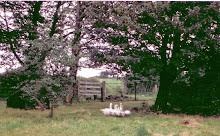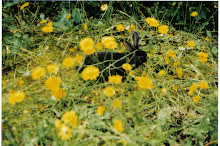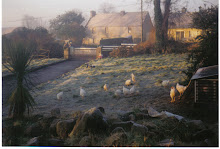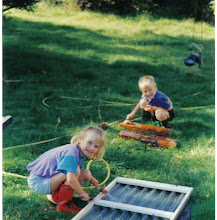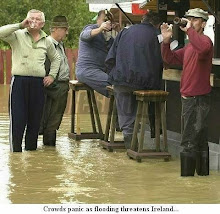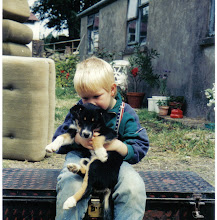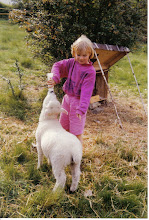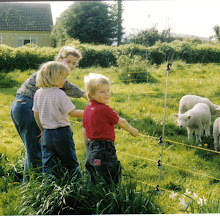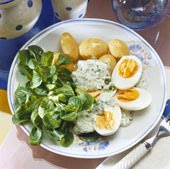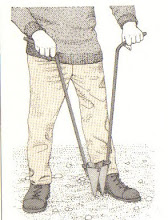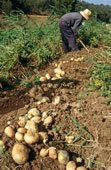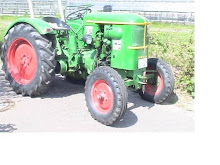You can't always buy organic, it's too costly. So my reasoning is if you don't even eat the skin of veggie, for example, for avocados and other peeled produce, pesticides aren't a problem. Right?
Not always. Some fruits' and vegetables' thick skins do protect the edible part from chemicals. But not all. The Environmental Working Group recently analyzed samples of 47 common produce items in the state that they're usually eaten (i.e., avocados were peeled, apples washed with water, etc.) then ranked them according to the amount and variety of pesticides the researchers found. Good news for my guacamole addiction: As I suspected, peeled avocadoes contain a small amount of pesticides, ranking 46th on the list. But bananas come in at a surprisingly high 27, and cucumbers at 19. "It’s really hard to use your intuition to figure out what’s going to have high pesticide loads," says Environmental Working Group spokesperson Amy Rosenthal. "Skin is something to take into account, but it doesn’t always make a huge difference."
1 (worst) Peach 100 (highest pesticide load)
2 Apple 93
3 Sweet Bell Pepper 83
Wednesday, March 24, 2010
Monday, March 22, 2010
Weed Control
As the summer progressed and lush greens surrounded us everywhere, we weren’t spared by the unwanted greens, i.e. weeds. The German word is much kinder:Unkraut= non-herb. The vegetable garden had priority in this ongoing battle. Often times, even the kids were recruited to pull some—after some instruction as what were weeds and what not. Mac had laid timber planks on the paths between his planted rows of potatoes, strawberries, and the young vegetables. In particular smallish courgettes/zucchinis and onions were doomed if we didn’t make regular guest appearances. Remember, the rows were 50 m long each. When using a hoe proved too risky around smallish specimen, you would squat down, then kneel, and eventually sit on the planks. Already in Germany, where our garden had been on a smaller scale, our children had spent a fair amount of their toddling years and childhood among the greenery. In particular Amy, who started walking late, was often parked on the ground were we worked. We had to keep an eye on her to prevent her from eating the dirt.
No question whether an ‘aspiring’ organic farmer would avail of the use of herbicides or not, understandably. We learned to mulch which was a novelty then. You couldn’t just buy mulch in Ireland. We used grass clipping which have a tendency to rot in the Irish rain. We used layers of newspapers which get unsightly and torn in too bad weather soon. Sheet mulch (black plastic sheets) came into fashion only later. So mainly it was back to backbreaking work.
The farmyard, however, made of tarmacadam, was a different story and a bone of contention between us. Mac didn’t mind letting the grass grow there. And grow it did nicely. The traffic of crossing animals and tractors encourages weed growth exponentially. Initially, I tried to pull the weeds by hand. The yard was about 10x30m. The width and work involved didn’t constitute so much of a problem. No, pulling the weeds unfortunately also tore up part of the tarmac in little patches. What to do if Round-up was not an option?
Mac bought a flame torch for me. Since it was my job or least desire to keep the yard clean.
With some trepidation I learned how to use it. It took about 2-3 hours to do the whole yard. In contrast to what handy commercials show you, you had to repeat the procedure at least once a day or two later. Otherwise the flame wouldn’t really destroy the cell structure and root as promised. Low and behold, it only spurred the weeds growth! Did I mention you can only use the torch on dry weeds or in dry weather? Unfortunately, the Irish weather tends to include a lot of regular rain. How to use a flamer http://www.gameco.com.au/index.php?idp=26&mod=page. In spite of the proper gear, I was fighting a losing battle.
No question whether an ‘aspiring’ organic farmer would avail of the use of herbicides or not, understandably. We learned to mulch which was a novelty then. You couldn’t just buy mulch in Ireland. We used grass clipping which have a tendency to rot in the Irish rain. We used layers of newspapers which get unsightly and torn in too bad weather soon. Sheet mulch (black plastic sheets) came into fashion only later. So mainly it was back to backbreaking work.
The farmyard, however, made of tarmacadam, was a different story and a bone of contention between us. Mac didn’t mind letting the grass grow there. And grow it did nicely. The traffic of crossing animals and tractors encourages weed growth exponentially. Initially, I tried to pull the weeds by hand. The yard was about 10x30m. The width and work involved didn’t constitute so much of a problem. No, pulling the weeds unfortunately also tore up part of the tarmac in little patches. What to do if Round-up was not an option?
Mac bought a flame torch for me. Since it was my job or least desire to keep the yard clean.
With some trepidation I learned how to use it. It took about 2-3 hours to do the whole yard. In contrast to what handy commercials show you, you had to repeat the procedure at least once a day or two later. Otherwise the flame wouldn’t really destroy the cell structure and root as promised. Low and behold, it only spurred the weeds growth! Did I mention you can only use the torch on dry weeds or in dry weather? Unfortunately, the Irish weather tends to include a lot of regular rain. How to use a flamer http://www.gameco.com.au/index.php?idp=26&mod=page. In spite of the proper gear, I was fighting a losing battle.
Tuesday, March 16, 2010
Elderflower Champagne
While we can expect a proliferation of things turning green here in the US in anticipation and celebration of St.Patrick's day − not only my lawn after a particularly cold winter in FL− I mean, rivers tinted , green beer, socks, hats and very other impossible kitschy items for people who aren’t even Irish, my blog continues with our first summer which progressed nicely.
Hawthorne hedges blooming white and red gave way to elders (common elder; sambucus nigra) that have a white-yellowish bloom before they turn into black berries in the autumn. We had made German friends who had a similar farm set-up to us who were experts on making wines. Not just from the homebrew kit that the local homebrew store had for sale. R&R made wines out of strawberries, rhubarb, redcurrants, blackcurrants and blackberries and elderberries. And a sherry-effect liquor to die for!
My Ex,Mac, considered himself a concerning wine drinker. In Germany, we had only drunk exquisite German dries and Bordeaux wines. Then when we went environmentally friendly, switched to drinking organic wines only because many vineyards –particularly in Chile- had taken to spraying pesticides from the air by plane. A Sunday Times article double paged feature described the congenital birth defects this caused for the 2nd generation of vineyard laborers already. No more such wines for us…!
Our first attempt was elderflower champagne which, strictly speaking, isn’t champagne of course. It hardly has any alcohol, yet it sparkles and is a refreshing spritzy drink even for kids.
Elderberry champagne:
Approx. 10 liters of water, 15 big elderflower clusters, ¼ l wine vinegar 2-3 untreated lemons, 1 kg sugar.
Besides these ingredients you need a big stone or earthenware; thick walled glass bottles, preferably old champagne bottles that can be secured with a cork and wire. Screw tops do blow of under pressure. Wait till you hear that story!
First go for a walk to cut these elderberry blossoms, fully blown, but not over yet. Boil the water, dissolve the sugar in it and cool down. Wash the untreated lemons in hot water and cut into slices.
Check elderflower blossoms for little critters and dirt. Use as much as possible from the thick green stems and then give the blooms together with the lemon slices into the stone pot. Add the wine vinegar to the cooled sugar water to and pour over the flowers and lemons in the stone pot. Cover with a cloth and leave in a sunny place for 4 days. Stir every day with a wooden spoon. Don’t fill the bottle too much but up 4 to 5 cm below the rim. For this filter the liquid through a muslin cloth or very fine sieve.
Seal the bottles and secure the corks! The best place to store them is in a box. Bring to a cooler place (the basement) and leave at least 14 days to mature (bottle fermentation). The champagne sparkles a little already, but at maturity, there's real power, or then again sometimes not.
The development of carbon dioxide differs from year to year. It must depend on the weather or the condition of the blossoms. You can’t predict the amount of CO2 in the bottle.
So be careful when opening the first bottle, unless you want to paint the ceiling anyway. Or better open the first bottle in the garden. Elderberry champagne tastes best chilled: a great refreshing drink on hot days.
Hawthorne hedges blooming white and red gave way to elders (common elder; sambucus nigra) that have a white-yellowish bloom before they turn into black berries in the autumn. We had made German friends who had a similar farm set-up to us who were experts on making wines. Not just from the homebrew kit that the local homebrew store had for sale. R&R made wines out of strawberries, rhubarb, redcurrants, blackcurrants and blackberries and elderberries. And a sherry-effect liquor to die for!
My Ex,Mac, considered himself a concerning wine drinker. In Germany, we had only drunk exquisite German dries and Bordeaux wines. Then when we went environmentally friendly, switched to drinking organic wines only because many vineyards –particularly in Chile- had taken to spraying pesticides from the air by plane. A Sunday Times article double paged feature described the congenital birth defects this caused for the 2nd generation of vineyard laborers already. No more such wines for us…!
Our first attempt was elderflower champagne which, strictly speaking, isn’t champagne of course. It hardly has any alcohol, yet it sparkles and is a refreshing spritzy drink even for kids.
Elderberry champagne:
Approx. 10 liters of water, 15 big elderflower clusters, ¼ l wine vinegar 2-3 untreated lemons, 1 kg sugar.
Besides these ingredients you need a big stone or earthenware; thick walled glass bottles, preferably old champagne bottles that can be secured with a cork and wire. Screw tops do blow of under pressure. Wait till you hear that story!
First go for a walk to cut these elderberry blossoms, fully blown, but not over yet. Boil the water, dissolve the sugar in it and cool down. Wash the untreated lemons in hot water and cut into slices.
Check elderflower blossoms for little critters and dirt. Use as much as possible from the thick green stems and then give the blooms together with the lemon slices into the stone pot. Add the wine vinegar to the cooled sugar water to and pour over the flowers and lemons in the stone pot. Cover with a cloth and leave in a sunny place for 4 days. Stir every day with a wooden spoon. Don’t fill the bottle too much but up 4 to 5 cm below the rim. For this filter the liquid through a muslin cloth or very fine sieve.
Seal the bottles and secure the corks! The best place to store them is in a box. Bring to a cooler place (the basement) and leave at least 14 days to mature (bottle fermentation). The champagne sparkles a little already, but at maturity, there's real power, or then again sometimes not.
The development of carbon dioxide differs from year to year. It must depend on the weather or the condition of the blossoms. You can’t predict the amount of CO2 in the bottle.
So be careful when opening the first bottle, unless you want to paint the ceiling anyway. Or better open the first bottle in the garden. Elderberry champagne tastes best chilled: a great refreshing drink on hot days.
Thursday, March 11, 2010
Farmville
I wanted to write about planting more fruit etc. I always get distracted by food/organic/farm related things in the news. Bear with me...
Watching Charlie Rose the other night shook my world. He interviewed Mark Pincus, the CEO of the greatest social gaming network. Zynga has just been voted Best Overall Startup Product of 2009. FarmVille was voted their Best App. (application for the uninitiated).
Farmville is at the top of their popularity list. Over 60 million “farmers”, more than in the real world. Grow delicious fruits and vegetables and raise adorable animals on your very own farm!
Where does this virtual interest come from? Because you can grow and harvest in no time? Without sweat and risks like bad weather? And you won’t get your hands dirty? So here I am on my blog telling you how we toiled the soil, brought lambs into the world, and plucked chickens. My avatar: the new Virtual Farmer’s Wife.
Farmville is game where you can farm with your friends, a social network. Got it? What’s wrong with that?
All these games are playable on Facebook. No wonder people withdraw from the real world and chose an online, virtual –may I say Ersatz- world? Remember the Tamagotchi of the late 90s? Where you could raise, feed and walk a dog? Sounds familiar? You probably guessed that I’m not a gaming or virtual reality person. “People really need to do something with each other” (Mark Pincus).” You don’t say!
You start off with crop ready to harvest. For that you get gold coins…without having to bother going to the market. Fallow land is plowed in a second. You can buy new seeds at the market and sow immediately. After ten minutes, soybeans are 2 % grown: Hey, Presto! Instant gratification!
For the rest of my article go to Opednews.com. See link on the right, please.
Watching Charlie Rose the other night shook my world. He interviewed Mark Pincus, the CEO of the greatest social gaming network. Zynga has just been voted Best Overall Startup Product of 2009. FarmVille was voted their Best App. (application for the uninitiated).
Farmville is at the top of their popularity list. Over 60 million “farmers”, more than in the real world. Grow delicious fruits and vegetables and raise adorable animals on your very own farm!
Where does this virtual interest come from? Because you can grow and harvest in no time? Without sweat and risks like bad weather? And you won’t get your hands dirty? So here I am on my blog telling you how we toiled the soil, brought lambs into the world, and plucked chickens. My avatar: the new Virtual Farmer’s Wife.
Farmville is game where you can farm with your friends, a social network. Got it? What’s wrong with that?
All these games are playable on Facebook. No wonder people withdraw from the real world and chose an online, virtual –may I say Ersatz- world? Remember the Tamagotchi of the late 90s? Where you could raise, feed and walk a dog? Sounds familiar? You probably guessed that I’m not a gaming or virtual reality person. “People really need to do something with each other” (Mark Pincus).” You don’t say!
You start off with crop ready to harvest. For that you get gold coins…without having to bother going to the market. Fallow land is plowed in a second. You can buy new seeds at the market and sow immediately. After ten minutes, soybeans are 2 % grown: Hey, Presto! Instant gratification!
For the rest of my article go to Opednews.com. See link on the right, please.
Saturday, March 6, 2010
Earth Bound
A downpour empties the rain choked bowl of a thundering sky
Earth pauses after the soaking
And basks in a gray green glow
Back lit by brushed metallic radiance
That moment just before a new sun breaks through
The last few fat rain drops
Splat on the tin roof of the chicken coop
Bothering brood hens fluffed wide
Over clutches of satin brown eggs
Each hen, eyes half closed in contentment
Chucking quietly to herself
The moist smell of new straw warmed under feathers
Rises
Then touches the fragrance of strawberries and lavender
From the garden
My small refuge in this frenzied world gone mad over itself
As it speeds down a highway that cuts through corn fields
Sandy Hartman
Written by a reader of my blog. SO kind of you! Thanks.
Earth pauses after the soaking
And basks in a gray green glow
Back lit by brushed metallic radiance
That moment just before a new sun breaks through
The last few fat rain drops
Splat on the tin roof of the chicken coop
Bothering brood hens fluffed wide
Over clutches of satin brown eggs
Each hen, eyes half closed in contentment
Chucking quietly to herself
The moist smell of new straw warmed under feathers
Rises
Then touches the fragrance of strawberries and lavender
From the garden
My small refuge in this frenzied world gone mad over itself
As it speeds down a highway that cuts through corn fields
Sandy Hartman
Written by a reader of my blog. SO kind of you! Thanks.
Monday, March 1, 2010
Organic certification
One of the frequently asked questions is :How do we know what we buy is really organic?
Your produce is not just organic because a producer says so. There are detailed requirements to be fulfilled in order to qualify for this label. I’m outlining this in detail because I keep encountering skeptics who doubt that organic products are really organic and how do you know that the supermarket is not just putting a label on it in order to raise prices?
If you buy a farm that so far has been farmed conventionally, it takes a few years of “conversion” until you can call yourself organic. Cattle farmers or beef and lamb meat producers like us had to start with letting your fields grow naturally, without the use of artificial fertilizers and pesticides. For that period, your produce is labeled “in conversion” after “an in-conversion license is granted to the successful applicant.” In the meantime the animals you have on your field must be raised without medication and growth promoters.
In Ireland, IOFGA is the official organization that certifies that produce and meat etc. are really organically grown—and that means from start to finish (Irish Organic and Farmers Association).
“The conversion period is the time frame that occurs between applying to IOFGA to convert to organic farming and getting a full organic symbol. In most cases this is two years. When the conversion period is successfully completed a full organic symbol is granted allowing produce to be sold as organic and to display the IOFGA symbol.” (http://iofga.org/certification-and-members/organic-certification/)
An inspector will come to your farm, write an inspection report that then will be examined by the Certification panel.
In Ireland over the past 10 years the organic market has enjoyed high levels of consistent growth. Even in times of economic pressure peoples’ priorities are sourcing food which has been produced with an emphasis on environmental, ethical and health concerns.
Perusing IOFGA’s website, I see you can search growers by product or county. It shows who is in conversion and who is certified. For homework: Note to blogger for homework: check what the American procedure is and compare!
IOFGA now runs classes on how to grow stuff organically (for school projects, hobby growers, allotment holders etc.)
We met lots of likeminded people through attending their meetings because in our neighborhood, nobody else was an organic farmer—yet. We met Jo who was the biggest producer of wheat and procured grain that I ground into flour for baking my breads and cakes; we also made friends with vegetable growers who had been farming organically for some time and had more experience than us. A lot of them were Germans like us or Dutch.
We organics weren’t that many altogether –yet in the early 90s.When my stint on the farm ended, Mac was the second biggest beef producer in the country—and only had 20 animals for slaughter that year.
Your produce is not just organic because a producer says so. There are detailed requirements to be fulfilled in order to qualify for this label. I’m outlining this in detail because I keep encountering skeptics who doubt that organic products are really organic and how do you know that the supermarket is not just putting a label on it in order to raise prices?
If you buy a farm that so far has been farmed conventionally, it takes a few years of “conversion” until you can call yourself organic. Cattle farmers or beef and lamb meat producers like us had to start with letting your fields grow naturally, without the use of artificial fertilizers and pesticides. For that period, your produce is labeled “in conversion” after “an in-conversion license is granted to the successful applicant.” In the meantime the animals you have on your field must be raised without medication and growth promoters.
In Ireland, IOFGA is the official organization that certifies that produce and meat etc. are really organically grown—and that means from start to finish (Irish Organic and Farmers Association).
“The conversion period is the time frame that occurs between applying to IOFGA to convert to organic farming and getting a full organic symbol. In most cases this is two years. When the conversion period is successfully completed a full organic symbol is granted allowing produce to be sold as organic and to display the IOFGA symbol.” (http://iofga.org/certification-and-members/organic-certification/)
An inspector will come to your farm, write an inspection report that then will be examined by the Certification panel.
In Ireland over the past 10 years the organic market has enjoyed high levels of consistent growth. Even in times of economic pressure peoples’ priorities are sourcing food which has been produced with an emphasis on environmental, ethical and health concerns.
Perusing IOFGA’s website, I see you can search growers by product or county. It shows who is in conversion and who is certified. For homework: Note to blogger for homework: check what the American procedure is and compare!
IOFGA now runs classes on how to grow stuff organically (for school projects, hobby growers, allotment holders etc.)
We met lots of likeminded people through attending their meetings because in our neighborhood, nobody else was an organic farmer—yet. We met Jo who was the biggest producer of wheat and procured grain that I ground into flour for baking my breads and cakes; we also made friends with vegetable growers who had been farming organically for some time and had more experience than us. A lot of them were Germans like us or Dutch.
We organics weren’t that many altogether –yet in the early 90s.When my stint on the farm ended, Mac was the second biggest beef producer in the country—and only had 20 animals for slaughter that year.
Subscribe to:
Comments (Atom)




























